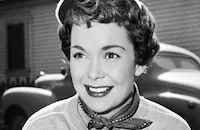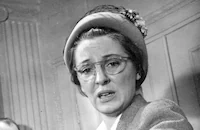Stage Fright

Brief Synopsis
Cast & Crew
Alfred Hitchcock
Jane Wyman
Marlene Dietrich
Michael Wilding
Richard Todd
Alistair Sim
Film Details
Technical Specs

Synopsis
In London, as budding actress Eve Gill helps a frantic Jonathan Cooper escape from the police, he relates the events that led to his being accused of murder: Actress Charlotte Inwood, Jonathan's lover, arrives at his door, her dress covered in blood, and tells him that she killed her husband during a quarrel. Believing it would be best for Charlotte to perform as usual, Jonathan goes to her house to get her a clean dress. After he collects the dress, he arranges things to look as if a thief broke in and killed Charlotte's husband. As he is leaving, however, Charlotte's maid, Nellie Goode, appears unexpectedly and sees him. He hurries home, where Charlotte suggests that he hide out. Telephoning Eve's house, he learns from her mother that Eve is rehearsing at the Royal Academy of Dramatic Arts. The police arrive to question him and pursue the runaway Jonathan to the Academy. Eve, who is in love with Jonathan, a longtime friend, believes his story and helps him evade the police. When they arrive at the boathouse where her father, Commodore Gill, lives, Eve asks him to take Jonathan across the channel to France. Later, while an exhausted Jonathan dozes, Gill points out that the bloodstain was smeared on Charlotte's dress, giving the lie to her story, and suggests that they show the dress to the police to prove Jonathan's innocence. When Eve asks Jonathan about the dress, however, he angrily throws it on the fire. Now Eve proposes to try to learn the truth from Charlotte. Against the advice of her father, Eve returns to London and waits with the crowd outside Charlotte's house. When the police leave, she follows them into a pub. She then pretends to faint, prompting Detective Wilfred Smith to offer his help. Eve quizzes him about the case, but he reveals nothing. He then offers to accompany her home and invites himself to tea with Eve and her mother the following day. Pretending to be a reporter, Eve approaches Nellie and offers her money to take her place as Charlotte's maid. Now posing as Nellie's cousin Doris, Eve learns that Charlotte claims to have ended her relationship with Jonathan, who then killed her husband out of jealousy. Later, she sees Charlotte kiss her friend, Freddie Williams. Eve returns home to meet Smith, whom she has nicknamed "Ordinary" Smith, for tea. Gill also appears unexpectedly and informs Eve that Jonathan has run away. After a few minutes, Eve returns to the theater to help Charlotte dress, leaving Smith behind, and Gill follows soon thereafter. Jonathan sneaks into the theater, and Eve overhears Charlotte tell him disinterestedly that she and Freddie will arrange for him to leave the country. When Jonathan realizes that Charlotte has been pretending to love him, he lies and says that he did not destroy her dress. Eve then contrives to warn Jonathan that the police are searching for him, and he escapes. Later, Eve and Gill return home to find Jonathan waiting for them. He admits that his love for Charlotte was foolish, but his words fall on deaf ears because Eve has begun to fall in love with Smith. Accompanied by Smith, Eve attends a society garden party, where Nellie demands more money from her. Eve decides to tell Smith everything, but Gill resolves to trick Charlotte into a confession by asking a small boy to present her with a doll whose dress is smeared with blood. His ploy upsets Charlotte, but she does not confess. Smith then discovers the truth about Eve's deception and believes that she was only pretending to be in love with him. Eve explains and reassures Smith that her feelings are sincere. Gill then suggests that Eve try to blackmail Charlotte and goad her into confessing. In a conversation that is broadcast to the police, Charlotte admits she was present when Jonathan killed her husband. The police then bring Jonathan into the theater to confront Charlotte, but he again escapes, and Eve, who still believes he is innocent, helps him. Meanwhile, Smith tells Gill that Jonathan was acquitted for an earlier murder when he claimed that he killed in self-defense. While they are hiding, Jonathan admits that he did commit murder at Charlotte's instigation and now knows that she wanted to be available to marry Freddie. Eve begs Jonathan to turn himself in, but when he threatens to kill her, she calmly leads him into a trap and summons the police. When he again attempts to escape, Jonathan is killed by the falling fire curtain.

Director

Alfred Hitchcock
Cast

Jane Wyman

Marlene Dietrich

Michael Wilding

Richard Todd

Alistair Sim
Sybil Thorndike

Kay Walsh
Miles Malleson
Hector Macgregor

Joyce Grenfell
Andre Morell

Patricia Hitchcock
Ballard Berkeley

Alfred Hitchcock
Crew
Fred Ahern
James Bridie
Whitfield Cook
Wilkie Cooper
Christian Dior
Colin Garde
Jack Haste
Alfred Hitchcock
E. B. Jarvis
Harold King
Louis Levy
Leighton Lewis
Louiguy
Edith Piaf
Cole Porter
Alma Reville
Terence Verity

Videos
Movie Clip




Trailer
Hosted Intro
Film Details
Technical Specs

Articles
Stage Fright
Stage Fright would prove to be Hitchcock's last picture filmed in England until Frenzy in 1971. With the exception of Jane Wyman (the only American in the cast) and German-born Marlene Dietrich, the cast list reads like a who's who of the British stage and screen: Alastair Sim, Kay Walsh, Michael Wilding, Richard Todd, Miles Malleson, Joyce Grenfell, Andre Morell, Irene Handl, and Dame Sybil Thorndike in the role of Wyman's mother. Thorndike was best known for her acclaimed stage work in Greek tragedies and plays like Saint Joan (The latter was tailored especially for her by George Bernard Shaw).
Depending on whose biography you read, the making of Stage Fright was either a pleasure or an ordeal. It certainly was a pleasure for Dietrich who enjoyed a passionate off screen love affair with co-star Michael Wilding during the filming. She also gave one of her best performances as Charlotte Inwood, singing star and murder suspect; it was the ideal role because it gave her an opportunity to sing. Her friend, Edith Piaf, granted Dietrich permission to use her own theme song, "La Vie en Rose," and Cole Porter wrote a tune specifically for Dietrich - "The Laziest Gal in Town." The latter song ran into trouble with the Code due to some sexual innuendos, resulting in the creation of a new verse to replace the risque original. In her biography, Marlene, Dietrich had this to say about Stage Fright: "Hitchcock filmed Stage Fright in London when food was still strictly rationed. He solved the problem by having steaks and roasts flown in from America and delivered to the best restaurants in London, and then after work, he would invite Jane Wyman and me to a princely dinner. "Ladies must be well fed," he would say, as we gratefully polished off the delicacies. These dinners were the only contact we had with him outside the studio. He kept us at a distance. Like many geniuses he didn't like being idolized."
One of those who fared less well than Dietrich on the set of Stage Fright was Jane Wyman though she has always been gracious to the director and her co-stars in print. Despite researching her character thoroughly - she worked with co-star Kay Walsh on her Cockney accent for one scene until she got it just right - Wyman didn't really develop a rapport with Hitchcock. He had mainly cast her for box office insurance (she had just won the Best Actress Oscar® for Johnny Belinda, 1948) but years later, he revealed to Francois Truffaut, "I ran into great difficulties with Jane. In her disguise as a lady's maid, she should have been rather unglamorous; after all, she was supposed to be impersonating an unattractive maid. But every time she saw the rushes and how she looked alongside Marlene Dietrich, she would burst into tears. She couldn't accept the idea of her face being in character, while Dietrich looked so glamorous, so she kept improving her appearance every day and that's how she failed to maintain the character."
Other trivia of interest for Hitchcock fans: Stage Fright was supposed to be filmed on the coast of England but bad weather prevented it. Instead, the entire movie was photographed on the sound stages at Elstree Studios. In his traditional cameo appearance, Hitchcock plays a spectator on the street who stares at Jane Wyman. Upon release, the film stirred up controversy among critics, some of whom accused it of being a 'dishonest whodunit.' This charge was aimed at the opening flashback sequence which is later revealed to be a lie. When you really think about it, it's an unwarranted criticism. After all, it's like accusing Dorothy of having a dishonest dream in The Wizard of Oz (1939) or criticizing Akira Kurosawa's Rashomon (1950) for presenting conflicting flashback accounts of the same incident, a device that even contemporary filmmakers have used in such movies as The Usual Suspects (1995) and Courage Under Fire (1996).
Producer/Director: Alfred Hitchcock
Screenplay: Whitfield Cook, Selwyn Jepson (novel), Alma Reville
Art Direction: Terence Verity
Cinematography: Wilkie Cooper
Costume Design: Milo Anderson, Christian Dior
Film Editing: Edward B. Jarvis
Original Music: Leighton Lucas, Cole Porter (song "The Laziest Gal in Town")
Mischa Spoliansky (song "When You Whisper Sweet Nothings To Me")
Cast: Marlene Dietrich (Charlotte Inwood), Jane Wyman (Eve Gill), Richard Todd (Jonathan Cooper), Michael Wilding (Inspector Wilfred Smith), Alastair Sim (Commodore Gill), Sybil Thorndike (Mrs. Gill).
BW-110m.
by Jeff Stafford

Stage Fright
Quotes
He was an abominable man. Why do women marry abominable men?- Charlotte Inwood
Trivia
turning to look at Eve in her disguise as Charlotte's maid.
Notes
Selwyn Jepson's novel first appeared as a serial in Collier's from 9 August-September 13, 1947. According to the production notes included in the film's file at the AMPAS Library, Marlene Dietrich's costumes were designed by Christian Dior. Some scenes were filmed on location at London's Royal Academy of Dramatic Art, in two residences in Mayfair, a London pub, the interior of the Scala Theatre and at locations around Chelsea. Director Alfred Hitchcock makes his customary cameo by walking past Jane Wyman on the street.
Stage Fright marked the first speaking role of Hitchcock's daughter Patricia. An article in New York Times reports that camera operator Jack Haste used the same self-propelling crane and special camera that were used in Hitchcock's "one-take" film Rope (see entry above). "The Laziest Gal in Town" was written especially for Dietrich by Cole Porter, and she made it one of her signature songs, performing it for years in her nightclub act.

Miscellaneous Notes
Released in United States Spring April 15, 1950
Released in United States Spring April 15, 1950















